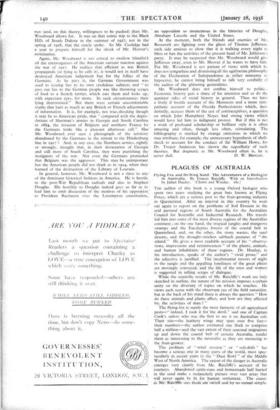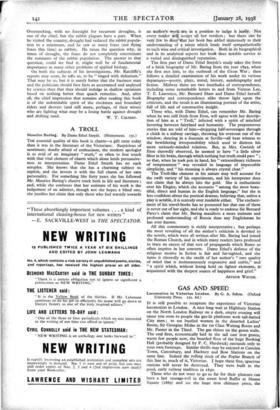PLAGUES OF AUSTRALIA
Flying Fox and Drifting Sand. The Adventures of a Biologist in Australia. By Francis Ratcliffe. With an Introduction by Julian Huxley. (Chatto and Windus. 16s.)
THE author of this book is a young Oxford biologist who spent two years studying the great bats known as Flying Foxes, which are a serious pest to the fruit-growing industry in Queensland. After an interval in this country he went out again to report on the problems of Soil Erosion in the arid pastoral regions of South Australia for the Australian Council for Scientific and Industrial Research. His travels led him into some of the most diverse regions of the Australian continent ; on the one hand, the tropical jungles and mangrove swamps* and the Eucalyptus forests of the coastal belt in Queensland, and, on the other, the stony wastes, the sand deserts, and the drought-stricken saltbush pastures of the inland." He gives a most readable account of his " observa- tions, impressions and reminiscences " of the plants, animals, and human inhabitants of these regions. Dr. Huxley,, in his introduction, speaks of the author's " vivid prose," and the adjective is justified. The insubstantial terrors of night in the jungle and the appalling loneliness of the great plains are movingly eonveYect, -and the life of the -men and wcknen is suggested in telling scraps of -dialogue.
While the scientific results of Mr. Ratcliffe's work are -.only sketched in outline, the nature of his mission imposes a certain unity on the diversity of topics on which he touches. He views each scene with the observant eye of the -field naturalist, but at the back of his mind there is always the question " How do these animals and' plants affect, and how are they affected by, the activities of man ? "
The flying. fox is surely the most fantastic of all agricultural pests—" indeed, I took it for 'the devil," said one of Captain Cook's sailors who was the first to see it on Australian soil. Their siie—the leathery wings may span over five feet— their numbers—the author estimated one flock to comprise half a million—and the vast extent of their_ seasonal migrations up and down the coastal belt of eastern Australia, render them as interesting to the naturalist as they are menacing to the fruit-grower.
The problein of " wind erosion " or " soil-drift " has become a serious. one in many parts of the world, most spec- tacularly in .recent years in the " Dust BOwl " of the Middle West of North Anierica. The extent of the danger in Australia emerges very clearly from Mr. Ratcliffe's account of his journeys. Abandoned cattle-runs and homesteads half buried in the sand make a melancholy picture over vast areas: that will never again be fit for human settlement. The causes as irdeltifitiffe sees iheiVate-vinie'cl and- by no,meanS, simple.
Overstocking, with no foresight for recurrent droughts, is one of the chief, but the rabbit plagues have a part. When he visited the country, drought had reduced the rabbit popula- tion to a minimum, and he saw as many foxes (not flying foxes this time) as rabbits. He raises the question why, in times of drought, the foxes do not completely exterminate the remnants of the rabbit population. The answer to that question, could we find it, might well be of fundamental importance in many other problems of applied biology.
On both the subjects of his investigations, Mr. Ratcliffe's reports may seem, he tells us, to be " tinged with defeatism." That may be so, but it is surely better that the business man and the politician should face facts as ascertained and analysed by science than that they should indulge in shallow optimism based on nothing better than quack remedies. And, after all, the chief impression that remains after reading this book is of the indomitable spirit of the stockmen and boundary riders and drovers (and still more, perhaps, of their wives) who are fighting what may be a losing battle against drought



















































 Previous page
Previous page